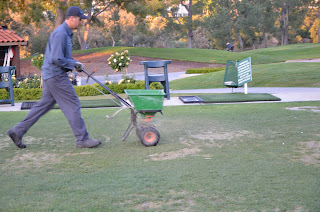Calabasas Country Club
Maintenance Department
I would like to give you a 30,000-foot view of the greens past, current and future conditions.
After being promoted to Head Golf Course Superintendent in October, rigorous lab work was conducted along with constant monitoring to drill-down to the source and to establish a base-line for greens health. The results were bleak, yielding figures of sodium 6X higher than plant health tolerability, compacted soil in an anaerobic state, and surprising abundances of Aluminum, Boron & Zinc. These conditions coupled with the heat late last summer were almost enough to destroy our 42 year-old greens. Also contributing to the problem was the high level of organic mater in the soil, so much so that the greens could barely be classified as a sand-based soil; a sand base is crucial to promote water peculation to flush out sodium and other unwanted elements.
I responded to these problems throughout Fall and Winter with applications of calcium and several specific acids, as well as frequent needle tine aerification. These applications along with the heavy rains helped to lower the sodium and pH levels back to normal levels, and also fostered root growth of 3 ½ inches. As a reference, the roots were measured in October at just ½ inch, which is not sufficient for long-term sustainability.
With Spring came the largest mission-critical soil correction project in my 6 ½-year tenure at Calabasas Country Club. I oversaw an aggressive deep tine aerification process in March, the effects of which can still be seen on the surface of most greens. While I understand the frustration that comes with any change to the aesthetics and playability of the greens, the aerification process was crucial to getting the greens as healthy as possible before Summer, and the high temperatures that test the greens health every day until November. Currently I'm please to report that the sodium levels have been stabilized to normal levels, and root mass reached down to 6 inches this week. These results would not have been achieved without the deep tine aerification in March.
Greens health is a slow, multi-step process which requires constant care and attention. First, I will continue to monitor sodium levels along with taking soil, water & tissue samples on a regular basis. Second, I will implement future needle and deep tine aerification throughout the Spring and Summer months to deliver much needed oxygen down to the root zone. Third, biweekly applications of calcium, acids, and fertilizers aid in literally "spoon-feeding" the greens back to health. All of this is part of a 3-year plan to change the soil composition to a much improved state that will favor healthy plant conditions for years to come. Many thanks for your patience and continued support of my efforts.
Regards,
Eric Wenzinger
Golf Course Superintendent





